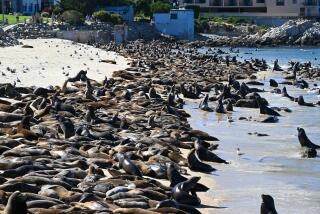Park Officials Take Aim at Islands’ Rats
- Share via
Scientists know the black rat by its Latin name, Rattus rattus, but to managers of Channel Islands National Park, the rodent may as well be Rattus non gratus.
Reviled in films such as “Ben” and blamed for carrying fleas that spread plague across medieval Europe, rats have taken up residence with authority on Anacapa Island, 11 miles off the coast of Ventura.
They probably got there from a shipwreck, perhaps aboard the Winfield Scott that ran aground during the Gold Rush. But park officials say now they have to go.
Rats have invaded breeding grounds of seabirds that nest on the island, eating eggs and occasionally chicks, and posing a threat to their survival, biologists say. Among the affected species is the rare Xantus’ murrelet, which nests on the island but is in sharp decline.
The island is also an important breeding colony for California brown pelicans, western gulls, Cassin’s auklet and ashy storm-petrels.
Worldwide, rats have caused up to 60% of all the extinction of birds and reptiles on islands, according to the Park Service. Rats also eat rare plants found only on islands.
“The rats have taken over the whole island at Anacapa,” said Gary Davis, senior scientist for the park. “This island is so small, it has no foxes or skunks or any other land predators, so when the rats got there, they had no natural competitors and they just proliferated.”
To restore a more balanced order, the Park Service is proposing the Anacapa Island Restoration Project, which focuses on eradication of black rats on Anacapa and San Miguel islands and identifies strategies to keep nonnative rodents from reaching the offshore park.
Park officials seek public comment on the plan, which is being developed. Mail comments to the AIRP superintendent at Channel Islands National Park, 1901 Spinnaker Drive, Ventura 93001, or call 658-5784 for information.
A public meeting on the matter is scheduled Dec. 8 at 7 p.m. at park headquarters in Ventura.
The anti-rat strategy is part of a wider program by park managers to evict alien species that have taken up residence on the five-island chain and caused significant environmental harm.
Among the creatures removed are sheep, cattle, pigs, burros and horses. The National Park Service is mandated by Congress to manage islands in a natural state as much as possible.
Black rats--which actually appear brown--are widespread in southern latitudes of the United States. They are believed to have originated in Southeast Asia, spread through Europe centuries ago and arrived in North America with colonists at Jamestown in 1609.
They are nimble climbers, congregating in ships and around docks and favoring mild climates such as in Southern California.
Rodent exterminators from the nonprofit Island Conservation and Ecology Group, based in Davenport, Calif., are studying rats on the Channel Islands. The group has conducted feral animal removals at offshore islands in Mexico and British Columbia.
Davis said the most likely strategy calls for the use of an anticoagulant bait, which causes rats to bleed to death.
More to Read
Sign up for Essential California
The most important California stories and recommendations in your inbox every morning.
You may occasionally receive promotional content from the Los Angeles Times.










